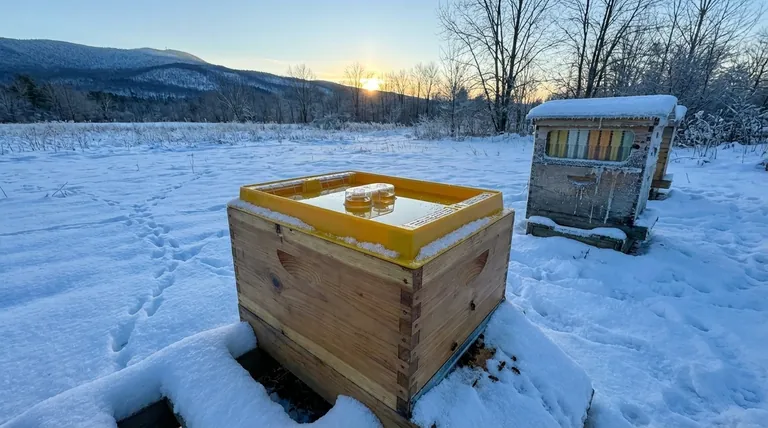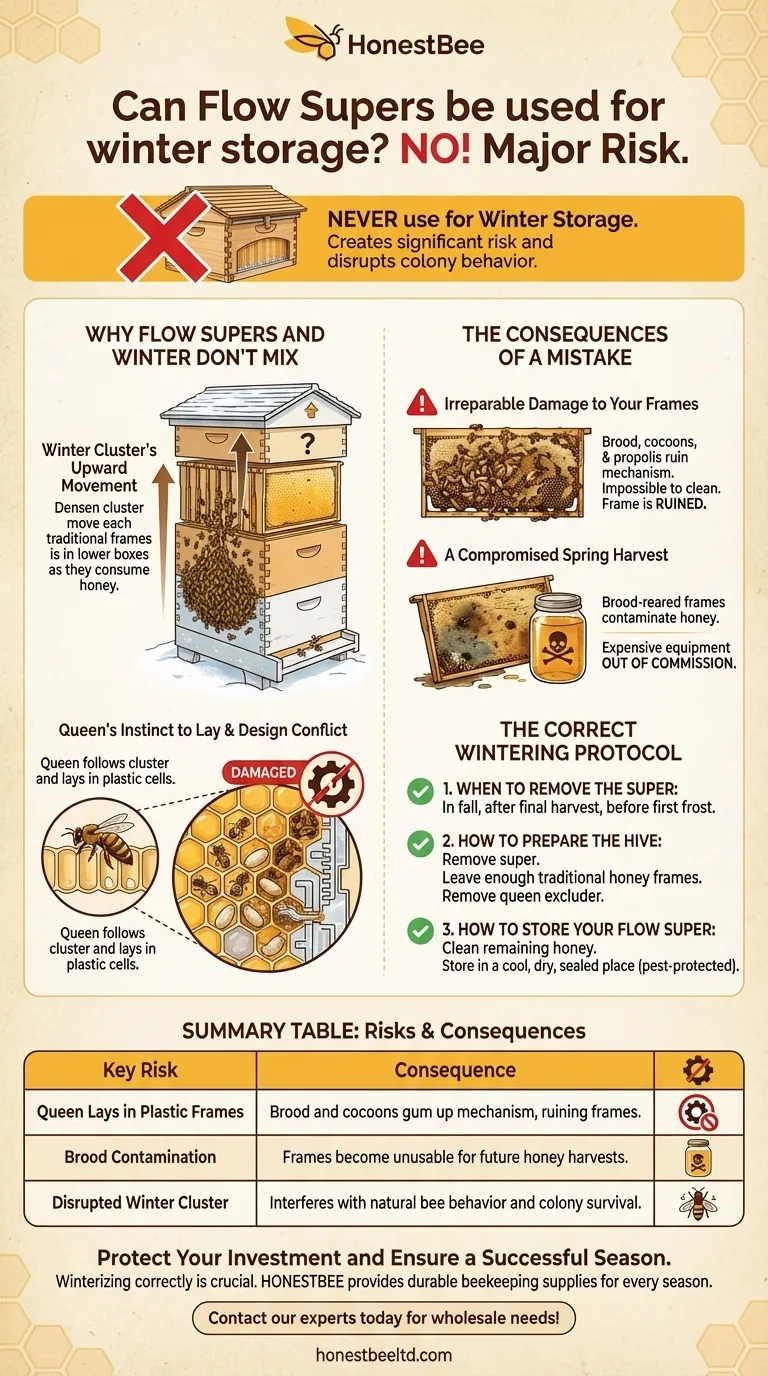No, you should never use a Flow Super for winter storage. Leaving a Flow Super on the hive over winter creates a significant risk to your equipment and disrupts the natural behavior of the colony. The queen may begin to lay eggs in the plastic Flow Frames, leading to a mess of brood and cocoons that can render the frames permanently unusable.
The core issue is a conflict between natural bee behavior and equipment design. As bees consume honey and move upward during winter, the queen will follow, and she will not hesitate to lay eggs in the plastic cells of a Flow Frame, causing irreparable damage.

Why Flow Supers and Winter Don't Mix
To understand why wintering with a Flow Super is a critical mistake, you must first understand how a honeybee colony survives the cold months.
The Winter Cluster's Upward Movement
Bees do not hibernate. Instead, they form a tight cluster inside the hive to generate heat and keep the queen warm.
As the winter progresses, this cluster slowly consumes its honey stores. The colony will start on the lower frames and methodically move upward as the honey in each section is depleted.
The Queen's Instinct to Lay
The queen's primary function is to lay eggs. As the cluster migrates into the uppermost box of the hive, she moves with them.
Once there, she will seek out empty cells to begin laying the first generation of spring bees. She does not differentiate between a traditional wax cell and a plastic Flow Frame cell.
The Design Conflict with Flow Frames
Flow Frames are designed exclusively for honey storage and extraction. Their internal mechanism consists of complex, moving plastic parts.
When a queen lays eggs in these cells, the resulting brood, larvae, and cocoons become lodged deep within the frame's mechanism. This is a situation the frames were never designed to handle.
The Consequences of a Mistake
Leaving the Flow Super on isn't a minor oversight; it can have expensive and damaging consequences for your equipment and your next honey harvest.
Irreparable Damage to Your Frames
Brood cocoons and propolis will quickly gum up the intricate moving parts of the Flow Frames. It is practically impossible to clean this organic matter out completely.
Attempting to "crack" or operate a frame filled with brood will damage the mechanism and create a sticky, unsanitary mess. In most cases, the frame will be ruined.
A Compromised Spring Harvest
Frames that have been used for brood rearing cannot be used for honey harvesting. Even if you could clean them, the remaining cocoons and debris would contaminate the honey.
This means the expensive centerpiece of your Flow Hive system will be out of commission when the spring nectar flow begins.
The Correct Wintering Protocol
Properly preparing your hive for winter is essential for both the bees' survival and the protection of your investment.
When to Remove the Super
You should remove your Flow Super in the fall, after your final honey harvest. The timing depends on your climate, but it should be done well before the first frost, when the bees' activity begins to slow down.
How to Prepare the Hive
After removing the Flow Super, ensure your bees have enough honey to survive the winter. This typically means leaving them with one or two standard deep or medium supers filled with honey on traditional frames. A queen excluder should also be removed to prevent the queen from being trapped below the winter cluster.
How to Store Your Flow Super
Once removed, clean any remaining honey from the Flow Frames. Store the super in a cool, dry place that is sealed and protected from pests like wax moths and rodents.
Making the Right Choice for a Successful Winter
Your goal is to ensure the colony is healthy and your equipment is ready for the next season. The right actions in the fall set you up for success in the spring.
- If your primary focus is colony survival: Ensure your bees have at least one full super of honey on traditional frames and that the queen is free to move with the cluster.
- If your primary focus is protecting your equipment: Remove, clean, and securely store your Flow Super before the first frost to prevent irreversible damage from brood.
Following the correct protocol ensures your bees are well-fed and your Flow Frames remain in perfect condition for the next honey harvest.
Summary Table:
| Key Risk | Consequence |
|---|---|
| Queen Lays in Plastic Frames | Brood and cocoons gum up the mechanism, ruining frames. |
| Brood Contamination | Frames become unusable for future honey harvests. |
| Disrupted Winter Cluster | Interferes with natural bee behavior and colony survival. |
Protect Your Investment and Ensure a Successful Season
Winterizing your hive correctly is crucial for both your bees and your equipment. As a trusted supplier for commercial apiaries and distributors, HONESTBEE provides the durable beekeeping supplies and equipment you need for every season. Don't let a simple mistake lead to costly damage.
Contact our experts today to discuss your wholesale needs and ensure your operation is set up for success from winter to harvest.
Visual Guide

Related Products
- Professional Hive Top Bee Feeder for Beekeeping
- Wooden Bee Brush with Double-Row Horsehair Bristles
- HONESTBEE Professional Entrance Bee Feeder Hive Nutrition Solution
- Plastic Handle Single Row Artificial Fiber Bee Brush
- Economy Small Scale Honey Dryer Dehumidifier Thickening Machine
People Also Ask
- What are the advantages of using top feeders for bees? Maximize Feeding Efficiency & Colony Safety
- What is a top feeder for bees? Maximize Colony Health with Efficient Feeding
- Do I need an inner cover with a hive top feeder? Optimize Your Hive Setup for Healthy Bees
- What is the best bee feeder for a hive? Choose the Right Feeder for Your Apiary's Scale
- What are the features of top feeders for bees? Maximize Hive Health with Safe, High-Capacity Feeding



















